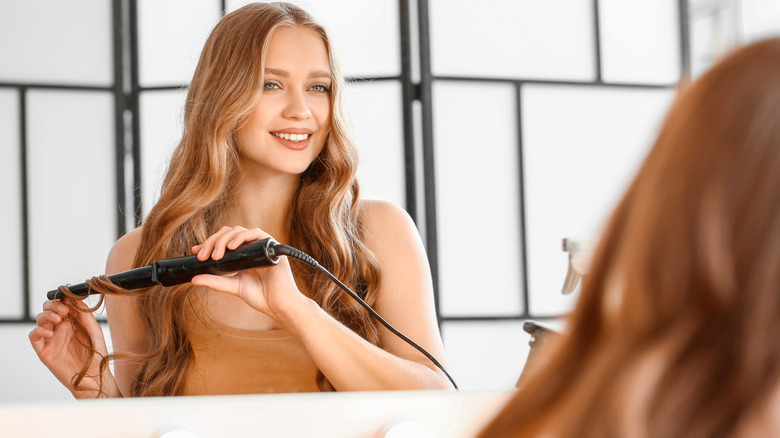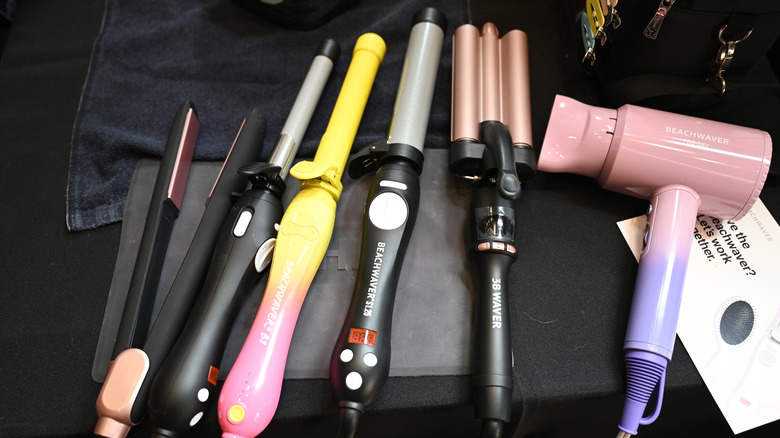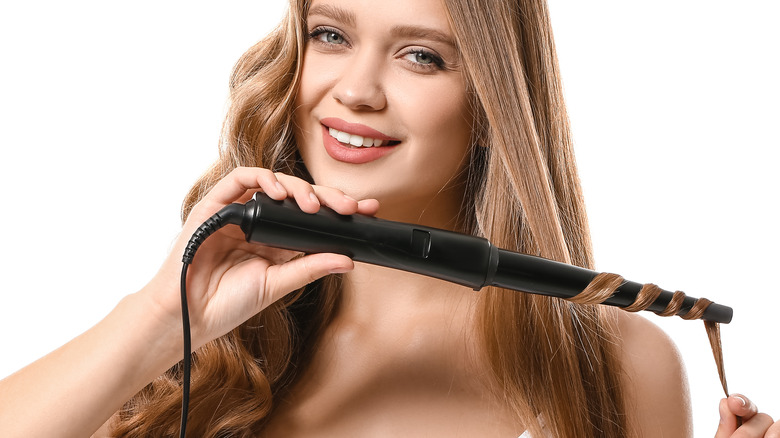Which Curling Iron Size Should You Use? Here's How To Decide
Beachy waves will always be in vogue, period. A whopping 43% of men favored a long, wavy hairdo, per a 2008 survey of 3,000 men conducted by Daily Mail. Additionally, the males who responded to the study stated that they preferred hairstyles that looked natural, with more than a third stating that they didn't like groomed hairdos that looked high-maintenance. Well, little do men know that effortlessly glossy curls are the hardest to achieve.
Turns out, curls come in different shapes and sizes. There are old Hollywood-inspired voluminous curls, and there are smaller, bouncier ringlets à la Taylor Swift's iconic hairstyle. No matter which curls you want to style, a versatile styling tool like a curling iron will always be needed. A curling iron works well on all hair types, especially for naturally curly hair or hair that's prone to frizz, celebrity hairstylist Eddie Cook tells TZR. Curling irons also come in varied sizes, and your chances of achieving desired curls depend largely on the right-sized curling iron. Here are tips on choosing the right curling iron sizes for desirable ringlets.
Anatomy of curls and curling irons
According to Curl Evolution, there are four types of curls. These include waves, s-curls, ringlet curls, and spiral curls. Needless to say, beachy waves are the soft, go-to style for an everyday romantic look. S-curls, on the other hand, refers to tighter, more defined curls with more body, like those of Shakira and Taylor Swift. Ringlet curls, otherwise known as corkscrew curls, are coiled, springy curls like those of Julianna Margulies and Annalynne McCord. Similar to ringlet curls, spiral curls also have a corkscrew pattern but are tighter and more densely packed, like those of Mariah Carey in the 90s.
Now, back to curling irons. The three main elements of curling irons, per CurlingIronsHQ, are the barrel, handle, and cord. The barrel is the most important part of a curling iron because that's where the heat required for styling comes from. There are multiple temperature settings to let you customize the heat to fit your natural hair type. Ceramic, metal, Teflon, titanium, and tourmaline are common materials used to make barrels. The barrel might take on a cone or cylinder form and is available in a variety of lengths and diameters that corresponds to the sizes of the curls you'd like to achieve. The rule of thumb for selecting the size of a curling iron is — the tighter the curls, the smaller the barrel's diameter.
Choosing rightly sized curling irons for your curls
Now, on to the sizes. For those going for subtle, wavy tresses that mimic Kate Middleton's effortless blowout look, don't hesitate to grab a two-inch barrel curling iron, according to Verily. To create bigger curves with more volume, a 1 ½-inch curling iron won't disappoint you. For sleekly defined retro Hollywood waves or loose waves with just the right amount of texture, a versatile one-inch iron is your ultimate tool. If spiral, 70s disco curls are your dream look, try a ¾-inch iron or ⅝-inch iron.
Whatever barrel you select, remember that the finer your hair, the lower the heat setting should be. Hair specialist Mirza Batanovic tells Makeup that the maximum temperature setting should be saved for the coarsest hair. Temperatures between 180 and 280 degrees are recommended for fragile and color-treated hair. To prevent thermal damage, apply conditioner and a heat protectant to your tresses before wrapping them around the barrel.


